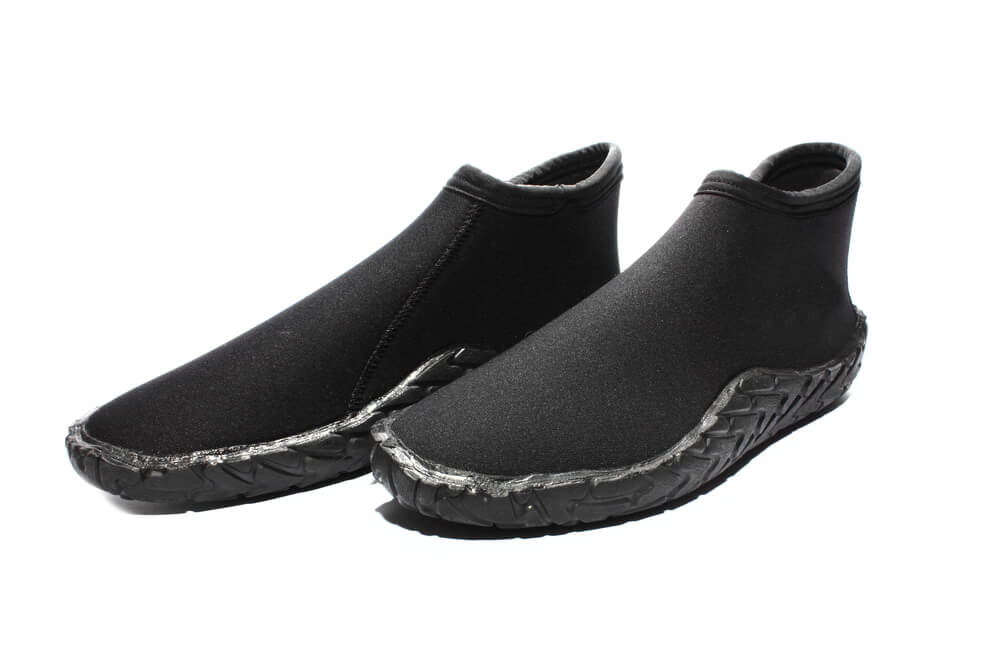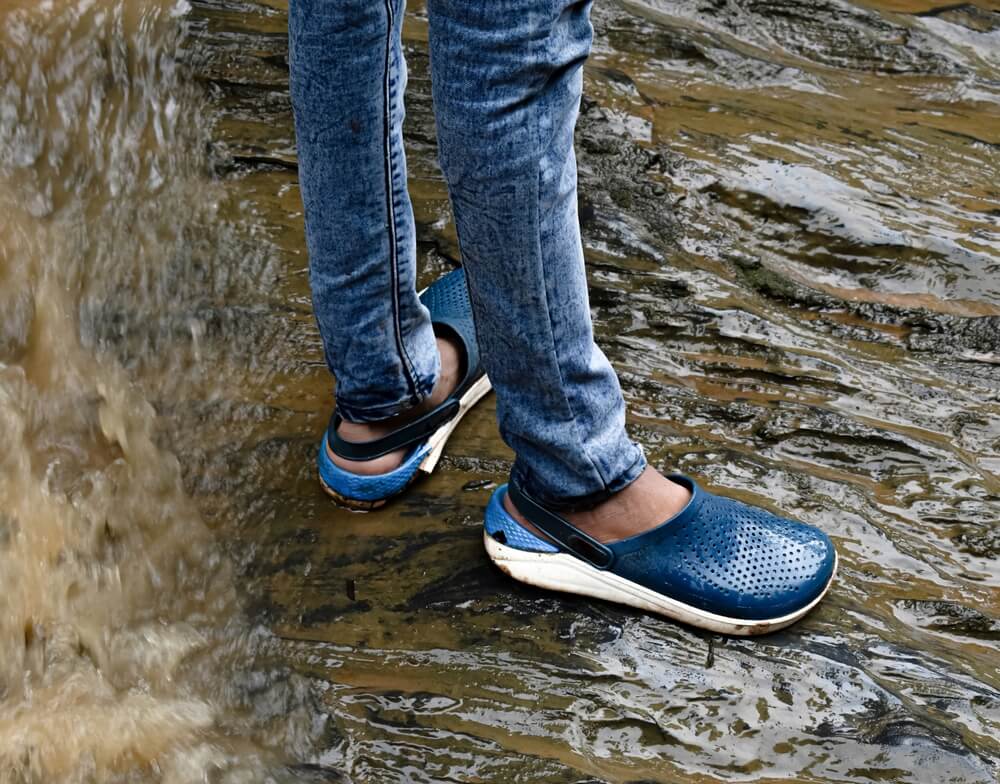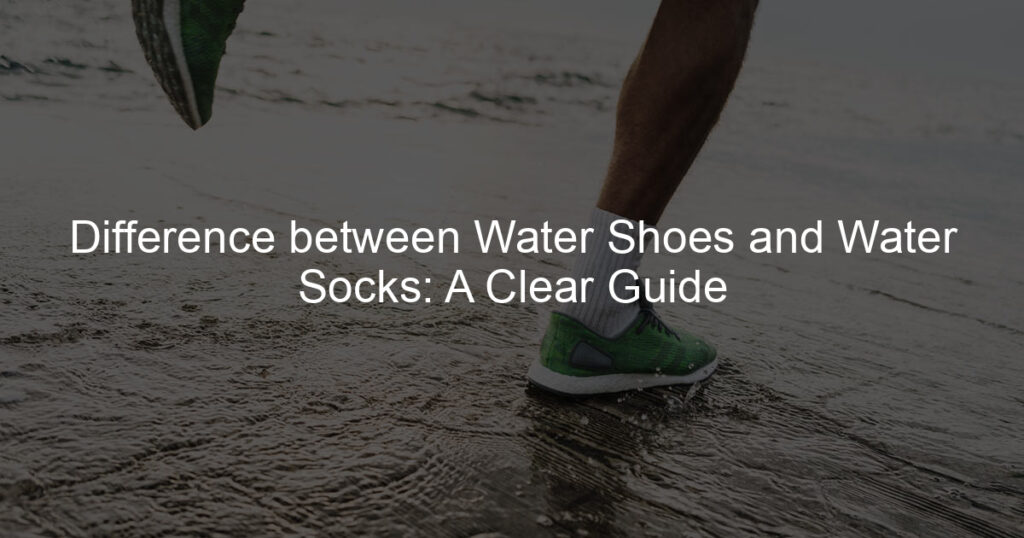When it comes to water-related activities, picking the right type of footwear is essential for both safety and comfort.
Many people may find themselves torn between water shoes and water socks, unsure of the key differences and which would be the better choice for their specific needs.
Knowing the Difference between Water Shoes and Water Socks can greatly improve your experience on your next aquatic adventure.
Water shoes are designed with additional features for protection against rocks, shells, or slippery surfaces, and they typically have a sturdy sole that provides extra grip when walking on wet terrain.
On the other hand, water socks are made from a lightweight material designed to enhance comfort while keeping your feet warm, and they usually offer less protection and support compared to water shoes.
Comprehending the situations and conditions specific to your activity will help determine which one would best suit your needs.
Key Takeaways
- Water shoes provide protection and grip for activities on rocky or slippery surfaces
- Water socks are lightweight, prioritize comfort, and focus on keeping feet warm
- Choosing between water shoes and water socks depends on the specific conditions of your activity
Understanding Water Shoes

Material and Design
Water shoes are typically made of materials like neoprene, mesh, and rubber. The design of water shoes focuses on providing support and grip to the wearer.
Neoprene and mesh are common choices for the uppers since they offer breathability and quick-drying properties.
Rubber is primarily used for the sole of the shoe, providing excellent traction and protection.
Variety and Fit
There are many different styles of water shoes available, catering to various sports and activities. Some are designed specifically for hiking, while others are better suited for swimming or spending time at the beach.
Lace-up water shoes, in particular, can provide a customizable fit, ensuring maximum comfort for the wearer. Ankle cuffs and cushioning further enhance comfort and support.
Protection and Comfort
Protection is an essential aspect of water shoes. A rubber sole provides excellent grip on slippery surfaces, reducing the risk of injury. In addition, the material and design of the shoe offer protection against sharp objects, rough terrain, and other hazards.
Comfort is also crucial, especially when spending long hours out on the water. Many water shoes are designed with cushioning and specific features to enhance comfort, such as flexible and waterproof materials.
Utility and Functionality
Water shoes serve various purposes and can be used for a range of activities like rafting, river hiking, camping, and more. Their versatility, drainage, and quick-drying properties make them a popular choice for outdoor enthusiasts.
Regardless of the activity, water shoes provide users with the functional benefits needed for a safe and comfortable experience, including the ability to navigate various terrains and wet conditions with ease.
Price and Durability
Price and durability are essential considerations when purchasing water shoes. Generally, water shoes are available at different price points to suit everyone’s needs. However, investing in a quality pair is important for those who plan on using them frequently.
Durable materials, such as rubber, nylon, and neoprene, contribute to the overall longevity and performance of the water shoes. So, while it’s important to choose a product that fits within your budget, be mindful of the balance between price and durability.
As I mentioned earlier, water shoes come in many styles, materials, and designs.
My main focus here has been to present a clear and concise overview of the essentials you need to consider when choosing water shoes, keeping functionality and practicality in mind for your specific requirements.
Exploring Water Socks

Material and Design
Water socks, also known as aqua socks, are made of a combination of materials, most commonly neoprene and lycra. Neoprene offers excellent insulation, which is especially important for cold water.
Lycra adds flexibility and breathability to the design, ensuring a comfortable, snug fit. The soles of water socks are usually made of thin rubber, providing a good grip on wet surfaces without compromising flexibility.
Some water sock models even incorporate breathable mesh for better ventilation.
Variety and Fit
When it comes to size and fit, water socks are available in a wide range of options. Just like regular footwear, it is essential to find the perfect fit for optimal comfort during water sports and activities.
Most water socks have a simple pull-on design, easing the process of putting them on and taking them off. However, you might also find lace-up designs that offer a more customized fit.
Keep in mind that water socks should fit snugly without restricting the foot’s movement. You can find water socks in various sizes, from small to extra-large, catering to all preferences and foot sizes.
Protection and Comfort
A key aspect of water socks is their balance between protection and comfort. While they don’t offer the same level of insulation as cold water footwear, like neoprene boots, they still provide a decent degree of insulation for moderately cold water.
Their slim, lightweight design ensures that they allow for natural, barefoot-like movement. This is particularly beneficial for activities like swimming and pool workouts.
Water socks prioritize foot protection by incorporating a rubber sole that offers grip on slippery surfaces. Some models also feature toe and heel caps to protect against impact with rocks or other underwater obstructions.
To maintain ventilation and avoid excess moisture build-up, some water socks include drainage slots and ventilating mesh.
In conclusion, water socks are a versatile and practical choice for water activities and sports that require a balance of protection, comfort, and functionality. With options for different materials, designs, and sizes, you’ll be sure to find a pair that suits your needs and preferences.
When to Use What

Activities and Terrain
When I engage in various water sports, I choose between water shoes and water socks depending on the activity and terrain. For activities like swimming, snorkeling, and paddle boarding, I prefer water socks as they are lightweight and have a snug fit.
On the other hand, water shoes are my go-to option for kayaking, canoeing, and water aerobics, as they provide better foot protection and grip and are suitable for both men and women.
When I’m fishing or wading on rocky shores, water shoes are my ideal choice due to their sturdy soles and added protection against sharp objects. In the case of more smooth terrains like sandy beaches and pools, I opt for water socks.
They offer minimal foot protection but provide me with sufficient traction to prevent slipping.
Weather Conditions
While both water shoes and water socks can be used across a range of water adventures, I choose based on weather conditions too.
For example, if I am engaging in an activity in colder environments like freshwater or saltwater, water socks with better insulation are necessary to keep my feet warm.
On the other hand, I find water shoes work better in warmer conditions as they usually have breathable material and allow water drainage, keeping my feet cool and dry.
In summary, my choice between water shoes and water socks highly depends on the activity, terrain, and weather conditions.
To make an informed decision, I consider factors like foot protection, warmth, and waterproof features to select the most appropriate footwear for my water adventures.
Difference between Water Shoes and Water Socks
Comparison based on Material
When it comes to materials, I observe that water shoes and water socks are constructed differently. Water shoes usually have a combination of mesh and rubber for their uppers, allowing for proper drainage and breathability.
On the other hand, water socks are primarily made of neoprene, a synthetic rubber material that provides good insulation and flexibility.
Neoprene water socks are beneficial in cold water situations, where they can keep your feet relatively warm.
Comparison based on Protection
In terms of protection, I find that water shoes offer more substantial support and safety for various water activities. They typically have a sturdy rubber sole, providing grip and slip-resistance on wet surfaces, as well as protecting the feet from sharp objects, coral, and hot sand.
Conversely, water socks have a thinner, more flexible sole – they do offer some protection, but not as much as water shoes.
Comparison based on Comfort
The comfort level of water shoes and water socks may vary depending on personal preference. I feel that water shoes offer more support due to their thicker soles and lacing systems, which allow for a customizable fit.
Yet, water socks have a snugger and more glove-like feel on the feet, reducing the chances of irritation and excessive rubbing.
The neoprene material of water socks also offers more insulation and is generally softer than the mesh and rubber components in water shoes.
Comparison based on Functionality
In terms of functionality, I notice that water shoes exhibit more versatility and are typically suitable for a wider range of water sports and outdoor activities, such as kayaking, paddleboarding, and hiking near water.
With their thick, slip-resistant soles, water shoes perform well across various terrains, unlike water socks, which are primarily designed for swimming and wading in water or wearing under fins while snorkeling or diving.
Overall, when deciding between water shoes and water socks, it is essential to consider both the intended use and personal preferences in terms of comfort, protection, and functionality.
Conclusion
In summary, water shoes and water socks serve different purposes and have distinct features.
As someone who spends time in aquatic environments, I’ve noticed that water shoes provide me with more support and protection, as they are constructed with durable materials like mesh, neoprene, and rubber soles.
They’re designed to protect my feet from slippery surfaces and sharp objects and are ideal for water sports and activities such as kayaking, surfing, and paddleboarding.
On the other hand, water socks are mainly used to add comfort and insulation in colder water. They are typically made from a lightweight, flexible, and quick-drying material such as neoprene or Lycra.
I find them more suitable for activities like swimming, snorkeling or use with fins. Their snug fit allows me to experience a better range of motion, which is essential for these activities.
In the end, the choice between water shoes and water socks will depend on my personal preferences and the specific water-based activities I engage in.
It’s important for me to assess the level of protection, support, and comfort needed for my feet and choose the appropriate footwear accordingly.
Frequently Asked Questions
What are the main differences in functionality?
In terms of functionality, water shoes provide better protection, support, and traction than water socks.
Water shoes are designed for more demanding activities, like hiking or water sports, whereas water socks are geared towards casual use, like swimming or walking on the beach.
How do materials used in water socks and water shoes vary?
Water socks are typically made from lightweight, flexible materials like neoprene or Lycra. This allows them to fit snugly and provides some insulation but offers little support.
On the other hand, water shoes often feature a combination of mesh, rubber, and other durable materials that improve protection, support, and breathability.
Is it necessary to use both water socks and water shoes together?
Using both water socks and water shoes together is not necessary, but it can provide extra comfort and support. Wearing water socks underneath water shoes can help prevent blisters and improve insulation in colder water.
When should I choose water shoes over water socks?
I recommend choosing water shoes when engaging in activities that require more protection, support, or traction.
For instance, water shoes are a better choice for hiking, boating, or participating in water sports, whereas water socks are suitable for casual swimming and lounging near the water.
What are the benefits of wearing water socks?
The main benefits of wearing water socks are their lightweight and stretchy nature, which provides a comfortable fit and some insulation in cold water.
They can also prevent blisters and provide a barrier against sand, pebbles, and other small debris.
Are there significant differences in comfort and fit?
Water socks generally offer a snug, almost second-skin fit, providing comfort and minimal interference with movement. Water shoes, while still comfortable, prioritize protection and support through their more substantial construction, which can feel bulkier.
The fit of water shoes is typically more adjustable, with laces or straps allowing for a personalized fit.









